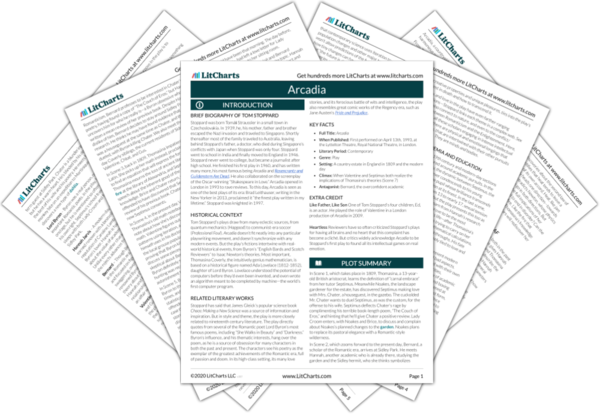Summary
Analysis
Back in the present day, Hannah and Valentine are looking at Thomasina’s old math textbook. Hannah reads Thomasina’s note about how she’s discovered a “method whereby all the forms of nature must give up their numerical secrets and draw themselves by number alone.” Thomasina, harking back to Fermat’s note about his proof, explains that the margin is too small for her to write out her equations.
Valentine explains Thomasina’s meaning, looking at both the textbook and Thomasina’s notebook, where she’s written more details and graphs. He tells Hannah that Thomasina was using iteration, a mathematical technique based on feedback, in order to describe a pattern. Valentine uses iteration to study grouse, but the technique has only been around for twenty years, and Thomasina’s use of it is mysterious. Valentine compares math’s progress in the 20th century as resembling the leap from classical, representative art to wildly imaginative modern art. Yet “the freaky stuff is turning out to be the mathematics of the natural world.”
Valentine explicitly connects mathematics and art. Thomasina seems to have felt this connection as well, with her poetic line about bells and bluebells in scene 3, for example. Both art and math attempt to unpack the mystery and beauty of existence. Valentine’s comments give us some useful context for Thomasina’s discoveries. She really was ahead of her time.
Themes
Hannah asks for more details about how Valentine’s work relates to Thomasina’s. Valentine explains that he’s trying to find the mathematical algorithm that describes patterns in the grouse population, whereas Thomasina’s work started with an algorithm. Valentine bemoans all the “noise” in the grouse data from the Sidley Park game books. It’s hard to pick out what the pattern might be. Hannah persists in trying to figure out if Thomasina had really hit on something important. Valentine is reluctant to see her work as anything more than random doodling, but he acknowledges that her iterated algorithm is a way of using math to represent nature—not the shapes of animals, but the shapes of populations and other complicated systems.
Valentine explains in simple terms how his project and Thomasina’s project relate. Both of them focus on patterns in nature that are common across many different types of systems, large and small. Iteration means exchanging a dependent variable (an output) for an independent variable (the input) over and over, so that each previous step becomes the basis for the next step. This process echoes Bernard’s academic research, where folly piles onto folly.
Themes
Hannah asks if Valentine might be able to draw the apple leaf using iteration. Valentine explains that iteration could roughly show you the shape of the leaf, by showing the general pattern within which randomness may occur. Valentine’s personality shifts to genuinely enthusiastic, even poetic, as he talks about how nature is governed by both “the unpredictable and the predetermined,” and ultimately the future can’t be predicted, because tiny changes can have a huge impact. Hannah and Valentine listen to Gus play the piano in the other room, and Valentine explains that, though Gus hasn’t talked since he was five, he seems to know more about the garden than their mother.
Valentine authoritatively answers the question that occupies Thomasina. Is the future predetermined, as Newton says? Can it be predicted with algebra? No, it can’t, because of the nature of iteration. This thinking is often called “chaos theory.” However, the play eventually teaches us that the universe will inevitably end in entropy, so on a very long timescale, the future is predetermined—it’s headed toward a sameness, where everything is “room temperature.”
Themes
Get the entire Arcadia LitChart as a printable PDF.

Bernard enters, thrilled to have discovered a note about “The Couch of Eros” penciled into Byron’s satirical poem “English Bards and Scotch Reviewers” (which Lady Croom mentioned in Scene 3). Bernard sees this as proof of his hypothesized Byron-Chater connection. Hannah mentions that she’s discovered a letter that notes that Brice and Mrs. Chater married in 1810, presumably after Chater’s death. Bernard reiterates his idea: Byron killed Chater in a duel over Mrs. Chater’s honor. He is entirely certain and plans to write a paper, but Hannah still isn’t convinced, as Bernard hasn’t found direct evidence for the duel.
Bernard’s passion and ego prevent him from following the correct scholarly steps. But his mistakes also show how hard it is to reconstruct the past. Even the records of a highly literate, upperclass family leave out important details. It’s hard to identify what’s important enough to record because of “the noise,” as Valentine terms it. Both Valentine and Bernard struggle to see a clear picture; they take alternate means to try to achieve not-so-dissimilar objectives.
Themes
Valentine cuts in to mention that he knows that Byron stayed at Sidley Park in 1809 because of the game books. Bernard, stunned, exits in search of the books. Gus enters, and Valentine prepares to leave. Hannah, still focused on Thomasina’s iterations, asks why no one did that kind of work until the 20th century. Valentine explains that it’s because iteration is so time-intensive that it’s only practical on calculators. Otherwise, you’d need a lifetime of repetitive work, and “you’d have to be insane.”
Valentine’s parting line about insanity recalls Hannah’s research on the Sidley hermit. He may have been doing just what Valentine describes—endlessly iterating numbers, creating huge piles of graphs and formulas. Though his papers have been burned, Hannah may start to feel a connection between the hermit and Thomasina.
Themes












